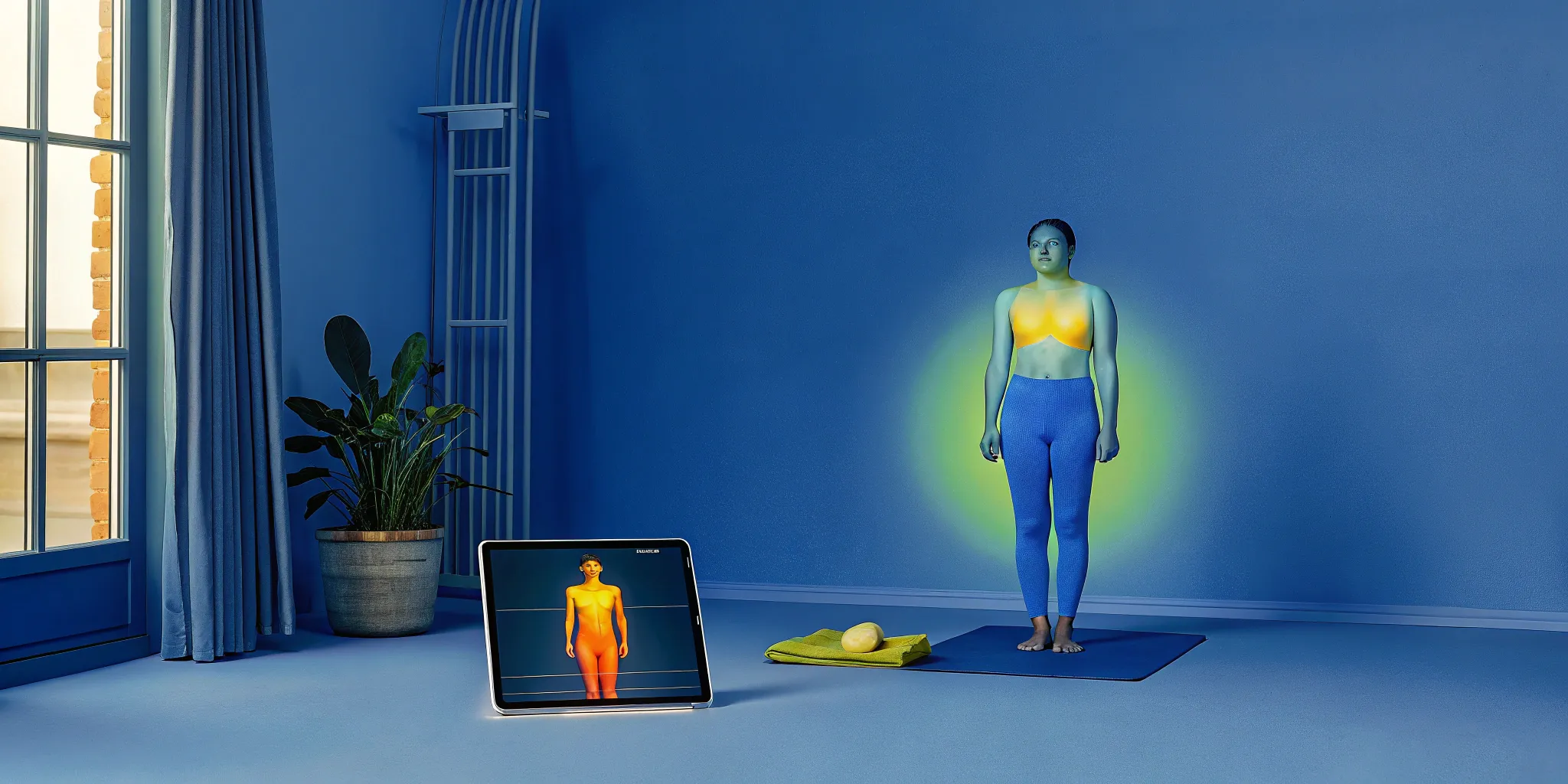How Does ShapeScale Measure Body Fat Percentage, & How Does It Compare To Other Methods?


Heading 2
Heading 1
Heading 3
Heading 4
Heading 5
Heading 6
Lorem ipsum dolor sit amet, consectetur adipiscing elit, sed do eiusmod tempor incididunt ut labore et dolore magna aliqua. Ut enim ad minim veniam, quis nostrud exercitation ullamco laboris nisi ut aliquip ex ea commodo consequat. Duis aute irure dolor in reprehenderit in voluptate velit esse cillum dolore eu fugiat nulla pariatur.
Block quote
Ordered list
- Item 1
- Item 2
- Item 3
Unordered list
- zz
- Item B
- Item C
Bold text
Emphasis
Superscript
Subscript
In the journey towards better health and fitness, understanding your body composition is crucial. Body composition refers to the proportion of fat, muscle, bone, and other tissues that make up your body. One of the most important metrics in body composition is body fat percentage - the amount of fat in your body relative to everything else.
Why is body fat such an important metric?
Body fat percentage, especially when considering fat distribution, can be a strong indicator of health risks. When body fat percentage is too high, especially visceral fat (the fat surrounding organs in the abdominal area), it can lead to several health risks.
Excess fat can lead to high blood pressure, elevated cholesterol levels, and increased risk of heart disease and stroke. High body fat, particularly around the abdomen, is strongly linked to insulin resistance and the development of type 2 diabetes. Studies have also shown associations between obesity and increased risk of several types of cancer, including breast, colon, and endometrial cancer.
While less common, having a body fat percentage that's too low can also be detrimental. For example, very low body fat can disrupt the production of sex hormones, potentially leading to fertility issues. The body needs some fat to produce and regulate hormones that support immune function, so an extremely low body fat percentage can weaken the immune system.

Furthermore, body fat percentage provides a more nuanced and accurate representation of an individual's physical health and fitness than weight or BMI alone. Someone might maintain the same weight but lose fat and gain muscle, which would be reflected in body fat percentage but not in overall weight. BMI only considers height and weight, not body composition - as a result, it can misclassify muscular individuals as overweight or obese, or classify people who lack muscle mass as healthy individuals.


ShapeScale Body Composition Prediction Model: how does it work?
ShapeScale offers a new approach to body composition measurement. It uses high-resolution 3D optical scanning to create a detailed model of the user's body. This visual data is then combined with demographic information and localized circumference measurements that are analyzed using machine learning algorithms.
These algorithms have been developed using data from over 800 DXA (Dual-Energy X-ray Absorptiometry) scans, which are considered to be a highly accurate method of body composition analysis. This allows ShapeScale to establish the reliability of its machine learning algorithms.
How accurate is ShapeScale’s body fat model?
The accuracy of ShapeScale is impressive - the body fat percentage you get from ShapeScale will be 97.2% close in accuracy to DXA scans which are the gold standard in body composition analysis. This level of accuracy is excellent for tracking changes over time and is significantly better than many other methods available outside of a lab setting.
For example, ShapeScale significantly outperforms bioelectrical impedance analysis (BIA) devices. Our tests have shown that ShapeScale provides body composition measurements that are about 25% more accurate than BIA devices.


It is important to note that even DXA scans have some variability, usually around 1-2 percentage points. The key is consistency - using the same method under similar conditions to track your progress. ShapeScale excels at this, giving you reliable measurements to guide your wellness journey.
While DXA widely regarded as the gold standard for body composition analysis, its use is limited by cost, accessibility, and radiation exposure. Recent advancements in 3D optical imaging technology, coupled with machine learning algorithms, offer promising alternatives for non-invasive and accurate body composition assessment. Let’s now explore other assessment methods, how they work, and what are the advantages and drawbacks of each method.
Other body composition assessment methods
There are several methods used to measure body fat percentage, each with its own advantages and limitations. Here are four of the other common techniques:
1. DXA (Dual-Energy X-ray Absorptiometry)
As highlighted earlier, DXA is widely considered the gold standard for body composition analysis. This method uses two low-dose X-ray beams with different energy levels to measure body composition.
How it works: The X-ray beams pass through the body and are absorbed differently by bone, fat, and lean tissue. The machine measures this differential absorption to calculate the density and amount of each tissue type.
Pros:
- Highly accurate
- Provides detailed body composition information (localized body fat & lean muscle mass; bone density)
Cons:
- High costs of machine ($45,000 to $80,000)
- Requires a lot of space
- Requires specialized equipment and trained technicians
- Involves small radiation exposure
- Poor data presentation // results are difficult to interpret for users
2. Skinfold Calipers
This method uses a simple tool to measure body fat percentage based on skin fold thickness at specific body sites.
How it works: A trained technician uses calipers to pinch and measure the thickness of skin folds at typically 3-7 locations on the body. These measurements are then input into equations that estimate overall body fat percentage.
Pros:
- Inexpensive
- Portable
Cons:
- Can be invasive (requires pinching body parts)
- Prone to human error
- Difficult to consistently measure the exact same spots
3. Bioelectrical Impedance Analysis (BIA)
BIA is a method that estimates body composition by measuring the body's resistance to a weak electrical current.
How it works: The device sends a weak electrical current through the body and measures the resistance (impedance) to this current. Fat-free mass contains more water and electrolytes, making it a better conductor of electricity than fat mass.
Pros:
- Widely accessible
- Non-invasive
Cons:
- Sends electrical currents through a user’s body
- Less accurate than other methods (tends to underestimate body fat by 3-5 percentage points)
- Highly affected by hydration levels
4. Hydrostatic Weighing
Also known as underwater weighing, this method uses the principle of water displacement to estimate body fat percentage.
How it works: Hydrostatic weighing compares a person's normal weight to their weight when completely submerged in water. Since fat is less dense than water (and other bodily tissues), a person with more body fat will weigh less underwater compared to a leaner person of the same weight.
Pros:
- Highly accurate when done correctly
Cons:
- Least accessible method
- Requires very specialized equipment
- Very inconvenient for the person being measured
What are the key takeaways for practitioners and patients?
Understanding these nuances is key for individuals to make more informed decisions about their wellness journey, and interpret their body composition results with greater accuracy. Education on these various methods and their limitations is essential for anyone serious about tracking their body composition effectively.
ShapeScale, offer a consistent alternative that has been calibrated against DXA scans, the gold standard in body composition analysis. It minimizes variables that could skew results, and ShapeScale’s machine learning approach provides a more accurate picture of progress, even if the absolute numbers might differ from the aforementioned methods.
The bottom line
ShapeScale offers several key advantages for businesses looking to track patients' body composition over time. Its accuracy is comparable to gold-standard methods like DXA, without the cons of other traditional methods.
On top of providing accurate body fat analysis, one of ShapeScale's unique features is its ability to generate 3D body models, providing a visual representation of changes that can be highly motivating for patients. As we continue to recognize the importance of body composition in assessing overall health and fitness, innovative technology like ShapeScale are poised to play a crucial role in helping people achieve their wellness goals with precision and ease.
How/Where can you try ShapeScale?
Use our interactive map to find the nearest ShapeScale partner locations.
We also consistently train our algorithm on back-to-back DEXA and Shape Scans. If you’re based in the Bay Area/San Francisco, and would like to participate to our data collection study, please email us at kate@shapescale.com.
Are you a wellness professional looking to explore the benefits of ShapeScale for your business? Book a demo or email us at sales@shapescale.com.




